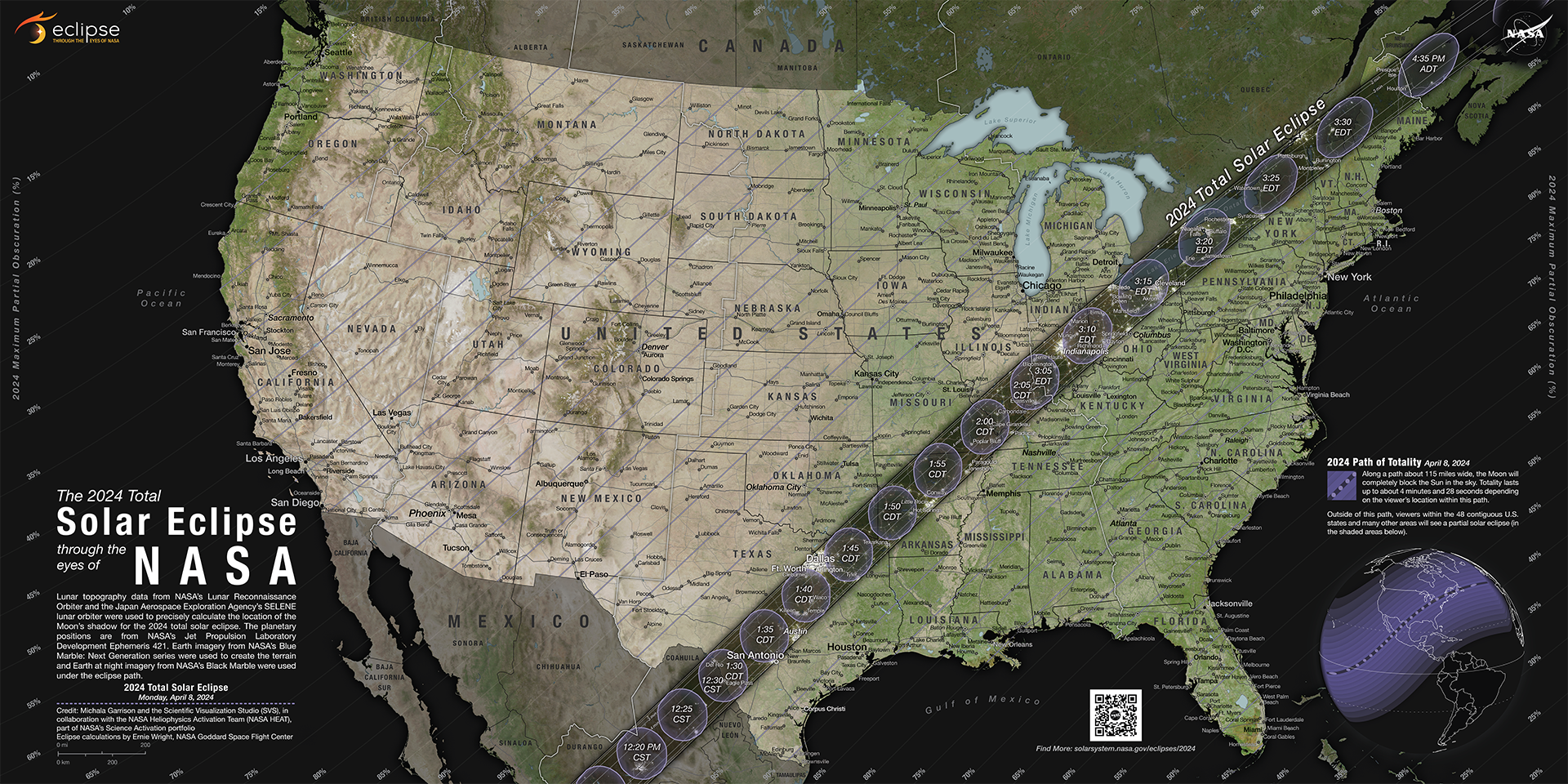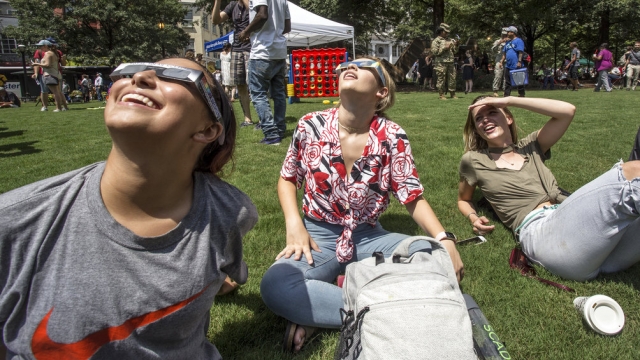April 8 will provide millions of Americans with a once-in-a-lifetime opportunity: the chance to witness a total solar eclipse without leaving home.
Nearly 31 million Americans will be on the total solar eclipse path of totality. Millions of others will be within a short drive of the path of totality.
You may have seen a lot of news coverage leading up to the big day but still might need clarification on the hype. Don't worry! Almost everything you need to know about the solar eclipse is here.
What is a solar eclipse?
A solar eclipse happens when the moon gets directly in between the Earth and the sun. Essentially, the moon is casting its shadow on the Earth.
These events can only ever happen during the new moon phase. A lunar cycle takes 29.5 days, but solar eclipses don't always happen during new moons. Usually, the moon's shadow goes just above or just below the earth.
But on April 8, the shadow will go directly over parts of North America.
What is the difference between a partial and total solar eclipse?
For most Americans, they will get to view — with proper eye protection — a partial solar eclipse. That is when the moon blocks some of the sun's light, but not all. Many major Northeastern U.S. cities can witness over 80% of the sun's light being blocked by the moon.
The total eclipse is far more spectacular. That is when the moon blocks all of the sun's light from directly reaching the Earth. The only visible part of the sun is its corona, which makes up the sun's outermost gases.
Even for areas that will have over 50% of the sun blocked, the effects of a solar eclipse are barely noticeable.
“If you're near the path of totality, take a couple hours off work or school and get in the car and just drive as close as you can to the middle of it. You don't need any special place, just a safe place to park your car and get out," said Terry Virts, retired NASA astronaut

What will I see during a total solar eclipse?
Besides the sun's corona, the sky will become twilight-dark. It will also be possible to see some of the brightest stars and planets, including Venus and Jupiter. These moments will be fleeting, however.
Totality will last anywhere from a few seconds to just over four minutes, depending on how close to the center of the path of totality you are.
It won't be midnight-dark outside but similar to the brightness just after dusk.
How rare are total solar eclipses?
In a global sense, total solar eclipses are not too rare. There will be a total solar eclipse in 2026. Another one will occur in 2027, and another in 2028. But for one to happen in any one spot in the world is very rare.
The next one visible from anywhere in the continental U.S. won't be until 2044.
Someone who is a resident of Ohio would have to wait until 2099. Most of Texas will have to wait until the 24th century.
There are eclipse chasers who have seen numerous total solar eclipses, but that can involve traveling significant distances.
SEE MORE: Scientist develops tool to photograph solar eclipses with smartphones
Where are the best spots to view the eclipse?
There are two significant factors to consider: length of time in totality and odds of cloud cover. After parts of Mexico enjoy the total solar eclipse, the moon's complete shadow will go over Texas. That shadow will continue drifting to the northeast into Maine before entering Canada.
Those in the center of the shadow will also experience the most extended duration of totality. Those in the middle of totality will get over four minutes.
Buffalo, New York and Cleveland are among the cities near the center of the path of totality. But there might be better spots to view the eclipse.
According to the National Weather Service, it is more likely than not that those areas will experience cloud cover on April 8. Forecasters suggest that historically, those in Texas have a better chance of seeing a total solar eclipse.
Many top eclipse chasers have said they will go to Texas to watch the eclipse, hoping it will be clear on April 8. Eclipse mapmaker Michael Zeiler plans to travel to Fredericksburg, Texas.
"The reason we chose Fredericksburg is because it's got pretty good weather prospects," he said. "It's right in the center of the path, but another key factor about Fredericksburg is its six highways radiating out of that gem. So if eclipse morning presents patchy clouds, we've got six directions that we could choose to relocate."
It is still possible that clouds will cover Texas while the Great Lakes enjoy a clear day. Stay tuned to the forecast.
There will also be numerous festivals and viewing parties coinciding with the eclipse. NASA has compiled a large list of events worth considering.
@scrippsnews Interested in watching the total solar eclipse in April? The path of totality touches more than a dozen states, but here are some of the most unique viewing experiences. #TotalSolarEclipse #space ♬ original sound - Scripps News
What will I need to view the total solar eclipse?
A total solar eclipse can be viewed without any eye protection — but only for the up-to-four minutes of totality is it safe to view the eclipse without eye protection.
For most of the duration of the eclipse, you will need to view the eclipse with glasses. NASA said solar eclipse glasses should be marked with ISO 12312-2 on them to confirm they are safe for usage during a solar eclipse.
Eclipse glasses can be reused indefinitely as long as they don't have any scratches or blemishes on the lens.
If you're unable to find eclipse glasses, another option is to make a pinhole camera using paper, a push pin, tape, scissors, and paper clip.
SEE MORE: What kind of solar eclipse glasses do I need?
What else can I expect?
Areas in and surrounding the path of totality are getting prepared for increased traffic. With the April 8 eclipse being within a 12-hour drive to most of the nation's population, millions are expected to enter the path of totality.
Experts also say other unusual things, such as a sudden temperature drop and animals exhibiting different behavior, could happen. Also, solar-powered lights could start to flip on.
NASA has an interactive map that allows you to see when the solar eclipse will occur and what the odds of it being blocked by clouds are.
"The hair on the back of my neck extends up," Douglas Duncan, a self-proclaimed "eclipse fanatic" and emeritus faculty member at the University of Colorado Boulder, said. "It gets cold, gets really cold. And then the people around me do all kinds of strange things. Some start to cry; some start to applaud; some start to cheer, but everybody does something. So it's quite a profound experience, and you have a challenge. All my career is to describe the indescribable as best you can."
SEE MORE: Doctor warns April 8 solar eclipse can cause anxiety
Trending stories at Scrippsnews.com



